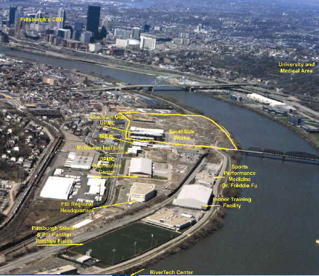Brownfield Redevelopment
Despite the fact that East Chicago is now the home of Mittal Steel, the worlds largest steel manufacturer, it still needs to grapple with the reality that steel production is quickly contracting and will very soon disappear from this region of the world. Below are three case studies of what can be done with the fallow brownfields left behind by steel producers. For many reasons East Chicago is fortunate to have survived as long as it has in the production of steel. This has provided the economic leaders of East Chicago with a wealth of case studies from which to learn. Although, East Chicago needs to work out a strategy tailored to its needs (to take advantage of unique opportunities), it has the strategies other municipalities have formulated from which to glean. In each case, the municipality had to retread its regional economy while adopting various reuse strategies.
Case Studies:
1) South Side Works, Pittsburgh LTV Property: What makes this example enticing is the fact that much of the land in need of redevelopment in East Chicago was also owned by LTV steel. Like the South Side Works East Chicago is located with in 20 minutes from a major city center. In the case of East Chicago, it is 20 minutes from downtown Chicago.
- Urban Redevelopment Authority of Pittsburgh
- Project Profile

2) The Sloss Furnaces
The Sloss story rests on becoming a National Historic Landmark. Proponents of preservation organized the Sloss Furnace Association to lobby for saving the site for historical and cultural importance to the City and its role as a symbol of the technology that once made Birmingham the foremost industrial center of the South.

3) Emscher Park Germany (for PDF)
Emscher Park, opened in 1989, is a bold attempt to re-use one of the largest industrial wastelands in the world. Built on ecological principles, the park offers a range of high quality recreation facilities for local people and tourists, as well as housing and offices. “The idea was born in the 1999 regional economic strategy, which identified the need to take forward large-scale environmental projects that would benefit recreation and regeneration and have a good effect on the region’s image.”

Case Studies:
1) South Side Works, Pittsburgh LTV Property: What makes this example enticing is the fact that much of the land in need of redevelopment in East Chicago was also owned by LTV steel. Like the South Side Works East Chicago is located with in 20 minutes from a major city center. In the case of East Chicago, it is 20 minutes from downtown Chicago.
- Urban Redevelopment Authority of Pittsburgh
- Project Profile

2) The Sloss Furnaces
The Sloss story rests on becoming a National Historic Landmark. Proponents of preservation organized the Sloss Furnace Association to lobby for saving the site for historical and cultural importance to the City and its role as a symbol of the technology that once made Birmingham the foremost industrial center of the South.

3) Emscher Park Germany (for PDF)
Emscher Park, opened in 1989, is a bold attempt to re-use one of the largest industrial wastelands in the world. Built on ecological principles, the park offers a range of high quality recreation facilities for local people and tourists, as well as housing and offices. “The idea was born in the 1999 regional economic strategy, which identified the need to take forward large-scale environmental projects that would benefit recreation and regeneration and have a good effect on the region’s image.”


0 Comments:
Post a Comment
<< Home